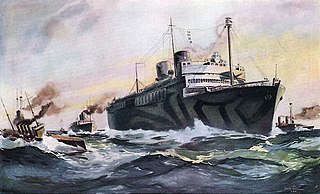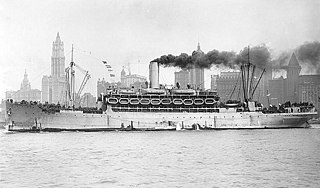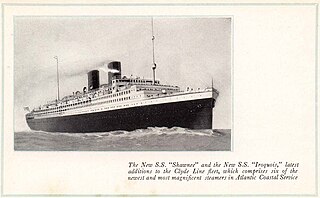
SS John W. Brown is a Liberty ship, one of two still operational and one of three preserved as museum ships. As a Liberty ship, she operated as a merchant ship of the United States Merchant Marine during World War II and later was a vocational high school training ship in New York City for many years. Now preserved, she is a museum ship and cruise ship berthed at Pier 13 in Baltimore Harbor in Maryland.

USS Comfort (AH-3) was a hospital ship for the United States Navy in World War I. She was the sister ship of USS Mercy (AH-4) but the two ships were not of a ship class. Comfort was known as SS Havana in passenger service for the Ward Line, and as USAT Havana in United States Army service before her Navy service. Her name was restored to Havana in 1927, and she was renamed SS Yucatán in 1935, and SS Agwileon in 1941. In World War II, she was known as USAT Agwileon and USAHS Shamrock in service for the United States Army.

USS Jeffers (DD-621/DMS-27), a Gleaves-class destroyer, was the only ship of the United States Navy to be named for Commodore William N. Jeffers.

USS Siboney (ID-2999) was a United States Navy troopship in World War I. She was the sister ship of USS Orizaba (ID-1536). Launched as SS Oriente, she was soon renamed after Siboney, Cuba, a landing site of United States forces during the Spanish–American War. After her navy service ended, she was SS Siboney for the New York & Cuba Mail Steamship Co.. The ship was operated under charter by American Export Lines beginning in late 1940. During World War II she served the U.S. Army as transport USAT Siboney and as hospital ship USAHS Charles A. Stafford.

USS Tatum (DE-789/APD-81) was a Buckley-class destroyer escort in service with the United States Navy from 1944 to 1946. She was scrapped in 1960.
USS Tackle (ARS-37) was a Tackle-class rescue and salvage ship acquired by the U.S. Navy during World War II. She served in North Atlantic waters, and returned home at war's end with two battle stars.

USAHS Blanche F. Sigman was a United States Army hospital ship during World War II. The ship was completed in April 1943 as Liberty ship SS Stanford White. When selected for conversion to a hospital ship, she was originally assigned the name USAHS Poppy, but never operated under that name. After being decommissioned as a hospital ship, she became U.S. Army transport USAT Blanche F. Sigman.

John L. Clem was built as the cargo and passenger liner Santa Ana for W. R. Grace and Company for service in Grace Line's South American service but was requisitioned before completion by the United States Shipping Board (USSB) in 1918 due to World War I. The ship was chartered back to Grace after completion until turned over to the United States Navy to be briefly commissioned as the troop transport USS Santa Ana (ID-2869) from 11 February 1919 to 21 July 1919.

SS Letitia was an ocean liner built in Scotland for service with the Anchor-Donaldson Line. She continued to serve with its successor company Donaldson Atlantic Line. At the start of the Second World War in September 1939, the British Admiralty requisitioned the ship for service and had it converted to serve as an armed merchant cruiser. She was withdrawn from this service in 1941 to become a troop ship.

Fort Victoria was a 7,784 GRT passenger steamship that was built in 1912 as Willochra. During the First World War she was requisitioned for use as a troopship. In 1920 she was sold and renamed Fort Victoria, serving until lost in a collision in 1929.

Dieppe was a steam passenger ferry that was built in 1905 for the London, Brighton and South Coast Railway. She was requisitioned during the First World War for use as a troopship and later as a hospital ship HMS Dieppe, returning to her owners postwar. She passed to the Southern Railway on 1 January 1923. In 1933 she was sold to W E Guinness and converted to a private diesel yacht, Rosaura. She was requisitioned in the Second World War for use as an armed boarding vessel, HMS Rosaura. She struck a mine and sank off Tobruk, Libya on 18 March 1941.
Claus Rickmers was a 5,165 GRT cargo ship which was built in 1923 for Rickmers Reederei AG. She was sunk by Allied bombing at Larvik, Norway in 1945 and then salvaged and towed to Bergen for repairs. She was then seized as a war prize) and ownership passed to the Ministry of War Transport (MoWT), being renamed Empire Carron on completion of repairs in 1947.
SS Empire Chamois was a 5,864 GRT cargo ship which was built in 1918 by Ames Shipbuilding and Drydock Co, Seattle. She was ordered by the Compagnie Générale Transatlantique but was requisitioned by the United States Navy and commissioned as USS West Mount with the pennant number ID-3202 in 1918. She was decommissioned in May 1919 and passed to the United States Shipping Board (USSB) as SS Westmount. In 1927 she was sold to the Dimon Steamship Corporation and renamed SS Pacific Redwood. She returned to the USSB in 1932 and passed to the United States Maritime Commission (USMC) in 1937. In 1940, she was passed to the Ministry of Shipping, passing to the Ministry of War Transport in 1941 and being renamed SS Empire Chamois. She was sold to Astral Shipping Co Ltd in 1946 and renamed SS Granview. In 1949 she was sold to the Compagnia Maritime del Este, Panama and renamed SS Chamois, serving until 1958 when she was scrapped. She was the last Ames-built ship afloat.

Cameronia was a British ocean liner which was built in 1920 by William Beardmore & Co Ltd, Dalmuir for the Anchor Line. She was requisitioned for use as a troopship in the Second World War, surviving a torpedo attack. In 1953 she was requisitioned by the Ministry of Troop Transport (MoTT) and renamed Empire Clyde. She was scrapped in 1957.
Theresia L M Russ was a 1,694 GRT cargo ship that was built in 1927 by Neptun AG, Rostock, Germany for Ernst Russ. She was requisitioned by the Kriegsmarine for two years during the Second World War. In 1944, she was sunk by bombing at Gotenhafen, German occupied Poland. The ship was raised and repaired in 1945. She was seized by the Allies at Copenhagen and passed to the Ministry of War Transport (MoWT) and renamed Empire Concrete.

SS Santa Rosa was a passenger and cargo ocean liner built for the Grace Line for operation by its subsidiary Panama Mail Steamship Company of San Francisco. She was the first to be launched and operating of four sister ships, the others in order of launch being Santa Paula, Santa Lucia and Santa Elena. All four ships, dubbed "The Four Sisters" and "The Big Four" were noted as the finest serving the West Coast and were of advanced technology. All served in World War II as War Shipping Administration (WSA) troop ships. Both Santa Lucia and Santa Elena were lost in air and torpedo attacks off North Africa.

Shawnee was a passenger steam turbine-powered ship built in 1926-1927 by Newport News Ship Building & Drydock Co. of Newport News for Clyde Steamship Company, a subsidiary of Atlantic, Gulf & West Indies Steamship Lines with intention of operating between New York and southern ports of the United States. During the World War II the liner was requisitioned by the US Government, and served as the United States Army Transport from September 1942 to March 1946 in the Atlantic, Mediterranean and Pacific. Following the end of the war, the ship was sold to a Portuguese company and renamed City of Lisbon, and subsequently resold to Yugoslavia, becoming Partizanka operating with the shipping company Jugoslavenska Linijska Plovidba until 1949 when the steamer burned while in drydock and was declared a total loss.

Empire Fowey was a 19,121 GRT ocean liner that was built in 1935 as Potsdam by Blohm & Voss, Hamburg for the Hamburg America Line. She was sold before completion to Norddeutscher Lloyd. While owned by Norddeutscher Lloyd she was one of three sister ships operating the service between Bremen and the Far East. Her sister ships were SS Scharnhorst and SS Gneisenau.
SS Tyndareus was a British steamship that was built in 1914–15 as a cargo liner for the Blue Funnel Line of the Ocean Steamship Company. Completed during the First World War, she served as a troop ship and was nearly sunk by a German naval mine, but without loss of life. Between the wars she operated commercially in the Pacific Ocean, before returning to military service in the Second World War. Her final civil role was to carry Islamic pilgrims from Indonesia to Mecca, before being scrapped in 1960.
Mohawk was a passenger cargo steam turbine-powered ship built in 1925–1926 by Newport News Ship Building & Drydock Co. of Newport News for Clyde Steamship Company with intention of operating between New York and Jacksonville. She was luxuriously equipped, and regularly carried celebrity passengers. In 1929, her schedule was extended to Galveston, and she also operated winter cruises to various Caribbean destinations. On 24 January 1935, after leaving New York City on one of her regularly scheduled trips, she suffered a failure of her automatic steering gear and collided with Norwegian cargo ship Talisman. Mohawk sank after about an hour with a loss of 31 crew and 16 passengers.













